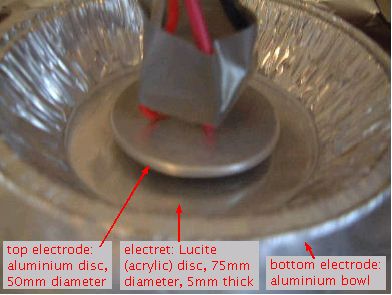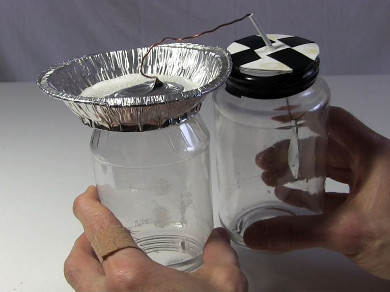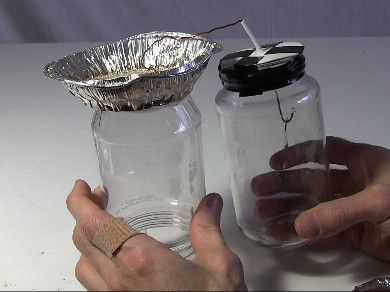Electrets - 75mm Acrylic Disks 1
These electrets were made of a 75mm disk of arcylic (Lucite). The top electrode was 50mm so the effective area should be around that. These electrets were made using the technique outlined on the main electret page.
Making the Electrets
I made two acrylic electrets, the first was melted to the point that it was obviously soft but not tacky and the second was melted to the point that touching it with a piece of wire and then pulling the wire away caused the wire to pick up a strand of melted acrylic.

For the second one, I preheated the top electrode by blowing hot air onto it with a heat gun in an effort to get more even heating of the acrylic. For the both electrets I used 6kV. I melted the second electet more than the first. Also, I let the first cool only 20 minutes whereas I let the second cool 30 minutes. After wrapping the foil around the first one, the top and bottom still felt very hot, though it was solid. This means a lot of the molecules were still vibrating around and so not necessarily with their polarities hardened in place. I figured this was not good so I let the second one cool an extra ten minutes.
Result - Testing the electrets
I first tested the electrets a few months after making them, as you're supposed to. I don't recall how I tested them but the results were that they didn't work. Six years later I tested them again with my homemade electroscope (see photos below.) In both cases I got no deflection on the leafs of the electroscope so these didn't work. Perhaps if I'd added a large resistor in series with the ground wire I could have limited the current and then it might have worked, but I didn't so I don't know.
For two electrets that did work, see my D'Addario dark rosin, Carnauba wax, Beeswax one (best results) or my Rosin from a rosin bag, Carnauba wax, Beeswax one.


